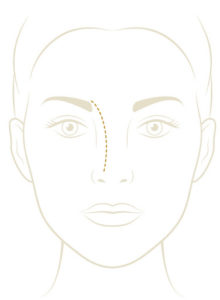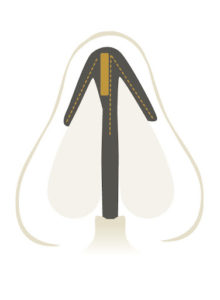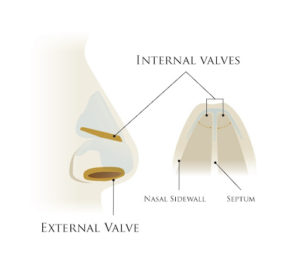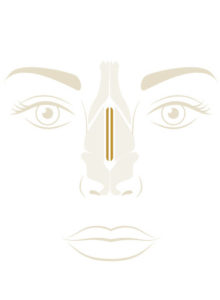Spreader graft placement typically spans the entire nasal middle vault and works by adding support to the nasal vault by providing an interior structure that is stable enough to expand the exterior cartilage and skin outward while resisting oppositional forces. This results in improved airflow through the nostrils.
Benefits of Spreader Graft Placement
Spreader graft placement is used to widen the nasal middle vault and has the following benefits:
- Restore or improve the brow-tip aesthetic line
- Improve airflow for nasal breathing
- Reinforce weakened or collapsed nasal structures
- Long-lasting results
Contact plastic surgeon Dr. David Cangello today at (646) 665-4222 to schedule a consultation for Spreader Graft Placement in NYC.
Spreader Grafts For Cosmetic Rhinoplasty
Spreader grafts are indicated in cosmetic rhinoplasty procedures when additional volume is needed in the middle nasal vault region. For cosmetic rhinoplasty patients with a narrow middle vault or who present with collapsed or depressed upper lateral cartilage, spreader grafts can restore the brow-tip aesthetic line by expanding nasal width.
Placing Spreader Grafts To Improve Cosmetic Appearance
The middle vault plays a major role in the cosmetic appearance of the nose because this region accounts for an entire 1/3 of the nasal bridge when seen on the frontal view. The ideal brow-tip aesthetic line is an imaginary curve that begins at the eyebrow and extends along the side of the nasal bridge and through the middle vault, before diverging away from the nasal tip (Fig. 3). If the brow-tip aesthetic line is disrupted by an abnormal contour—such as narrowing or collapse of the upper lateral nasal cartilage—in the middle vault, the entire midsection can create abnormal shadowing or a pinched appearance when looking at the nose from the frontal view. The diagram demonstrates a patient with an inverted “V” deformity, which occurs when the upper lateral cartilages are inadvertently separated from their connection with the nasal bones in primary rhinoplasty. They collapse inward and create the inverted “V” appearance (Fig. 4).


Spreader Grafts For Corrective Rhinoplasty
When it comes to improving nasal function in reconstructive or corrective procedures, spreader grafts help open the internal nasal valve by broadening its width and therefore the nasal air passages. If the angulation of the valve is less than 10-15 degrees, achieving a 1-2 degree change in middle vault width by placing spreader grafts between the upper lateral cartilage and the dorsal septum can make a significant difference in airflow and a dramatic improvement in breathing.
It’s important for reconstructive or corrective rhinoplasty patients to understand that the placement of spreader grafts will always widen the middle vault. In that vein, while a spreader graft can improve nasal function, a possible byproduct of this surgical technique is a visible widening of the middle upper dorsum from the frontal view of the nose.
Placing Spreader Grafts To Improve Nasal Function
Spreader grafts are indicated in reconstructive rhinoplasty procedures for several reasons. Spreader grafts are generally used to correct functional breathing problems by opening up the internal nasal valve in the nose’s middle vault region above the nasal tip cartilages and below the nasal bones (Fig. 5).

As you can see in Figure 5, the internal nasal valve (red) is the section of the nose at the lower end of the middle vault and the junction at which the dorsal septum and upper lateral cartilage forms an angle. In an average Caucasian nose this valve is typically between 10-15 degrees while in ethnic noses, the angulation can vary. Because the internal valve has the highest resistance to airflow compared to other nasal regions, it plays a critical role in nasal breathing. If the angle at the internal valve’s junction is less than optimal, it can increase airflow resistance and lead to an increase in nasal obstruction.
Internal valve related nasal obstruction can occur in patients who have undergone previous rhinoplasty where the middle vault was compromised or in patients for whom the upper lateral cartilages are naturally weak. Patients with weakened or collapsed upper lateral cartilage due to prior surgery or genetics can experience difficulty breathing through the nose.
Determining Candidacy For Spreader Graft Placement
Those with cosmetic nasal defects such as the inverted V deformity mentioned above, or crooked dorsums are often good candidates for spreader grafts. Additionally, those with breathing issues may benefit from placement. Dr. Cangello is an expert in rhinoplasty procedures and experienced with internal nasal valve evaluations. To assess the internal valve’s structure and stability, he’ll perform a physical examination called the Cottle maneuver.3 To begin, Dr. Cangello will have the patient breathe normally through the nose. Then he’ll pull the cheek out to one side, using a manual technique to open the internal nasal valve. If this Cottle maneuver leads the patient to experience improved breathing it is interpreted as a positive Cottle sign and indicates that spreader graft placement may improve nasal breathing.
Spreader Graft Procedure
Spreader grafts can be placed using an open or a closed rhinoplasty approach. An open approach requires an incision across the columella to lift the nasal skin and expose the interior middle vault. This exposure is ideal for optimal placement and subsequent suturing of spreader graft into place. Once the spreader grafts have been sutured, the upper lateral cartilage is restored into its original position and finally, the middle vault is remodeled with the spreader graft(s) in situ. In rhinoplasty patients who have skin that is thinner than average, Dr. Cangello may determine that a temporalis fascia graft be placed over the spreader grafts in the middle vault to provide extra cushion and prevent contour abnormalities.4
Spreader Graft Placement in NYC with Dr. Cangello
As NYC’s leading rhinoplasty surgeon, Dr. Cangello provides custom treatment plans and superior results. His expert ability to achieve optimal noses that are both functional and beautiful is derived from decades spent honing his expansive skill in the nuanced field of cosmetic and reconstructive rhinoplasty. Contact us today to schedule your consultation for spreader graft placement or learn more.
1 European Archives of Oto-Rhino-Laryngology. The value of spreader grafts in rhinoplasty: a critical review. Available at: https://www.ncbi.nlm.nih.gov/pmc/articles/PMC3321146/. Accessed May 28, 2021.
2 Annals of Plastic Surgery. A double-layered, stepped spreader graft for the deviated nose. Available at: https://pubmed.ncbi.nlm.nih.gov/19461268/. Accessed May 28, 2021.
3 American Journal of Rhinology & Allergy. Effects of the Cottle’s maneuver on the nasal valve as assessed by acoustic rhinometry. Available at: https://pubmed.ncbi.nlm.nih.gov/17882916/#:~:text=The%20Cottle’s%20maneuver%20(CM)%20is,farther%20inside%20the%20nasal%20cavity. Accessed May 28, 2021.
4 Yonsei Medical Journal. Various Applications of Deep Temporal Fascia in Rhinoplasty. Available at: https://www.ncbi.nlm.nih.gov/pmc/articles/PMC4276752/. Accessed May 28, 2021.
5 Plastic and Reconstructive Surgery. Systematic Surgical Approach to Alar Base Surgery in Rhinoplasty. Available at: https://pubmed.ncbi.nlm.nih.gov/33234955/. Accessed January 29, 2021.


